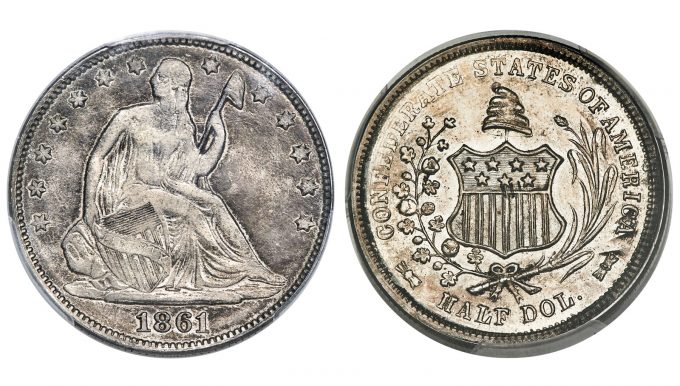As the song says, "Mele Kalikimaka is the thing to say on a bright Hawaiian Christmas day…" Collectors will definitely be celebrating when the Big Island Collection of Hawaiian Coinage and Tokens crosses the auction block at Heritage Auctions’ US Coins Signature® event Dec. 16-19, just in time for the holidays.

The aptly named Big Island collection features 15 lots in the sale from the state known as a tropical vacation getaway, but also one with an important numismatic history.
"The Big Island collection tells the story of Hawaii’s monetary history, including tokens that circulated during a shortage of coinage," Heritage Auctions Senior Vice President Sarah Miller said. "This collection also includes a lovely example of what ‘might have been’ with the fascinating Reginald Huth pattern."
Highlights from the Big Island collection include, but are not limited to:
An 1881 5C Hawaii Five Cents MS65 PCGS. Medcalf-2CN-1, KM-2 can be identified as one of the original 1881 strikes minted in Paris on behalf of the owner of a nickel mine in New Caledonia, who offered to produce five-cent pieces for the Hawaiian Islands. The obverse inscription identifies King Kalakaua as the "King of Sandwich Islands," the name for Hawaii. The reverse design had a spelling error in the Hawaiian motto, leading to speculation that the combination of errors was enough for King Kalakaua to reject the coinage proposal.

An 1847 1C Hawaii Cent MS65 Brown PCGS. CAC. Medcalf 2CC-1, crosslet 4 in date. This is the second-rarest of five varieties for the 1847 cents, which represented the first official coinage for the Kingdom of Hawaii. The obverse features a portrait of King Kamehameha III. The legend includes his name followed by KA MOI ("The King"). The reverse shows the denomination HAPA HANERI ("Hundredth Part") within a wreath that includes nine berries left and nine berries right. AUPUNI HAWAII ("Kingdom of Hawaii") is above.

Sometime around the turn of the century, an unknown die sinker produced a number of fantasy pieces in various metals patterned after the Hawaiian coinage of 1883. It appears he used the original hubs from 1883 to prepare the dies. An 1884 1/8D Hawaii Fantasy Strike Hub Impression 7.5g MS66 PCGS appears to be one of a set of three gold fantasy pieces that surfaced in the fabulous collection of King Farouk. John Dannreuther believes only two sets of fantasy pieces were struck in gold. Although the PCGS holder lists "1884" as the date of this piece, the date on the coin itself is 1883.
Apart from the Big Island Collection, the auction is stacked with superlative examples that will be a highlight of any collector’s coin cabinet.

A 1863 $1 MS67 NGC. OC-1, Low R.3 was included when Heritage Auctions sold the collection of baseball Hall of Famer Andre Dawson in 1998. In the catalog from that sale, it was described as "(one) of the most awe-inspiring and, indeed, memorable Seated Liberty dollars we have ever had to privilege to offer at auction." Since that time there has been no increase in number at the highest level of preservation for this date. One other coin has been certified MS67 by NGC, while PCGS has only grade a single coin (11/21). In 1998, Dawson consigned dozens of coins with his name listed on the pedigree line of the encasement. However, it has been years since we have seen another coin with his name in the pedigree, leading us to believe most have been upgraded or crossed over, leaving very few coins directly attributable to his collection.

A 1797 $1 10×6 Stars, Large Letters, B-3, BB-71, R.2, MS63 NGC.Die State III is one of the two or three finest known specimens for the coin, which typically is found in XF or lower grades. This piece stands in stark comparison to the typical Small Eagle Bust Dollar and would make a wonderful addition to either a type set or date set. It serves as an excellent exemplar of both the variety and also the Small Eagle type, which was struck only from 1795 to 1798.

A 1879 $4 Flowing Hair, Judd-1635, Pollock-1833, JD-1, R.3, PR66 Ultra Cameo NGC supports the theory that many numismatic collectors go after what was collected in the past. Such is the case with the 1879 Flowing Hair stella. These four-dollar gold patterns have long been included in sets alongside regular-issue coinage, and the tradition continues. In fact, the stella is the only pattern issue with its own section in the annual Guide Book, in between the three-dollar gold piece and half eagle, each of which, unlike the stella, actually circulated.

An 1831 10C PR66 PCGS. JR-2, R.7 as a proof is a rarity, because Capped Bust dimes are rarely found in proof format; in 1997, David Akers estimated six to eight 1831 JR-2 proof dimes. PCGS estimates 15 to 20 1831 proofs, for all varieties, though the true figure is likely lower.

Only four surviving original Confederate half dollars survive, and they are out of reach for all but the wealthiest collectors. But the Scott restrikes, including a 1861 50C Scott CSA Restrike, Breen-8002, Bertram-B861-267, MS64 PCGS. CAC., are within reach for far more collectors. Leading New York dealer J.W. Scott purchased the original Confederate die in 1879 from Ebenezer Locke Mason, Jr., who in turn obtained from B.F. Turner, Chief Coiner at the New Orleans Mint when the originals were struck in 1861. Scott procured 500 1861-dated halves, planed off the reverses, and struck them with the original Confederate die.
"Type collectors and early American history enthusiasts alike will find plenty to be excited about this December," Miller said. "If you are seeking a top-quality Bust Dollar or Seated Dollar for your type set, the lovely 1863 Seated Dollar NGC MS67 from Andre Dawson’s collection or the 1797 Small Eagle Bust Dollar NGC MS63 would be standout additions to your collection."
For more information and images of all lots in this sale, visit HA.com/1337.
About Heritage Auctions
Heritage Auctions is the largest fine art and collectibles auction house founded in the United States, and the world’s largest collectibles auctioneer. Heritage maintains offices in New York, Dallas, Beverly Hills, Chicago, Palm Beach, London, Paris, Geneva, Amsterdam and Hong Kong.
Heritage also enjoys the highest Online traffic and dollar volume of any auction house on earth (source: SimilarWeb and Hiscox Report). The Internet’s most popular auction-house website, HA.com, has more than 1.5 million registered bidder-members and searchable free archives of five million past auction records with prices realized, descriptions and enlargeable photos. Reproduction rights routinely granted to media for photo credit.





